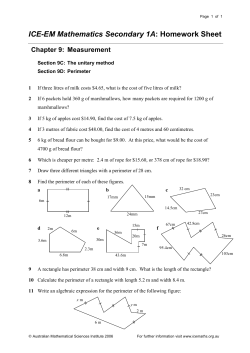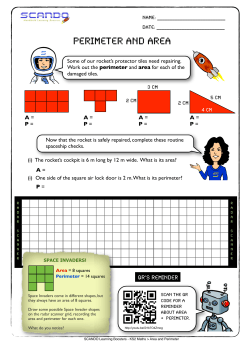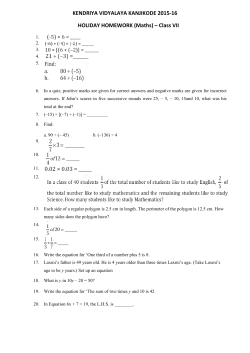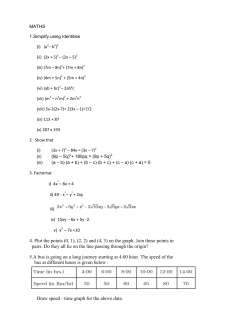
Detailed solutions
LAGRANGE PREPARATORY TEST 2015
COMPLETE SOLUTIONS
1.
The value of N in the equation: -4 x -2 + N = -4 is (8 + N = -4 and N = -12) -12.
2.
The natural numbers between 1 and 15 that have only 2 factors are: 2, 3, 5, 7, 11, and 13. These
numbers are all the prime numbers between 1 and 15.
3.
The number 29 (512) is closest to 500.
4.
The number of squares (of all sizes) whose vertices
coincide with the points in the diagram is equal to
10. There are 6 small 1 x 1 squares, two 2 x 2
squares, and two other squares that are shown
in the diagram.
5.
.
25% of a number is equal to (0.8 x 200) 160. This
number is equal to (4 x 160) 640 and twice the same
number is equal to (2 x 640) 1 280.
6.
The sum of all the prime factors of 50 {2, 5, 5} is equal to 12.
7.
The minimum number of biscuits that she can sell is the LCM of 10 and 8. The LCM of 10 and
8 is (2 x 2 x 2 x 5) 40.
8.
Mathew has paid $6.30 for 2 hot dogs and 3 fries. Mathilda has paid $6.20 for 3 hot dogs and 2
fries. For 5 hot dogs and 5 fries, they should pay ($6.30 + $6.20) $12.50.
9.
The perimeter of a rectangle is equal to 28 cm. The largest possible area of a rectangle having a
certain perimeter always happens when its length is equal to its width. The largest possible area is
equal to the area of the square whose side measures (28 ÷ 4) 7 cm. This area is equal to
(7 cm x 7 cm) 49 cm2.
10. The central number (the one in the middle) of 5 consecutive natural numbers always
represents the average of the 5 numbers. If this number is N, we can say that the sum of these 5
numbers is 5N. The sum of these 5 consecutive natural numbers is always a multiple of 5 (5N).
The largest natural number, less than 50, that is equal to the sum of 5 consecutive natural numbers
is thus 45.
11. The coordinates of the image of point A of line segment
AB after it is reflected in the y-axis and is moved
(translation) by a value of t (3, -3) is (5, -1).
12. Starting with 0, all integers are written in increasing
order: 0, 1, 2, 3, 4, 5, 6, 7, 8, 9, 10, 11, 12, 13, 14,
… . From 0 to 9, 10 digits are written; from 10 to 19,
20 digits are written; from 20 to 29, 20 more digits
are written. The 50th digit that will be written is a 9.
13. The value of (80%)% is (0.8)% or 0.008.
14. First a triangle, like the one shown in the
diagram, can be traced inside the 2 x 2 bold
square. By symmetry or rotation, we can
trace 3 other triangles in the same bold square.
By downward translations of these 4 triangles,
we can trace 8 more triangles. By translations
to the right of these 12 triangles, we can trace
24 more triangles. The maximum number of
isosceles right-triangles having the same
dimensions that could be drawn in this grid
is 36.
15. The measure of angle ABC is equal to
(180º - (60º + 58º)) 62º.
16. The diagram on the right hereafter represents
the universe of all the possible sums (36)
when two dice are rolled. The bold pairs
(12) represent the cases where the sum
of the two dice is smaller than 7. The
probability of getting a sum smaller than
7 is (15/36) 5/12.
17. The average of two integers is -2. The
sum of these two integers is (2 x -2) -4.
The sum of these two integers and the
number -5 is equal to (-4 + -5) -9.
18. A team has 20 players. Five have
blond hair, 12 have blue eyes, and
4 of them have both blond hair and
blue eyes. Because 4 of these players
have both blond hair and blue eyes,
we can conclude that (5 - 4) 1 of these
players has blond hair but not blue
eyes and (12 - 4) 8 of these players
have blue eyes but not blond hair.
The number of players that have
neither blue eyes nor blond hair is
equal to (20 - (1 + 8 + 4)) 7.
19. The value of the numerator so that the fraction is equal to 3 is 3n + 3.
20. The number of rectangular cereal boxes
of 7 cm x 25 cm x 50 cm that can be
stacked in a rectangular box of
49 cm x 100 cm x 151 cm is (7 x 4 x 3) 84.
21. If x = -2, the value of 2x - x2 - x3 is
(2(-2) - (-2)2 - (-2)3 = -4 - 4 + 8) 0.
22. The sum of the numbers that form its 7th
line is (2 x 1 + 2 x 6 + 2 x 15 + 20) 64.
23. The graph shows the relation between the
speed V (in km/h) and the time t (in seconds)
of a car that has moved for 35 seconds. From
rest, the car increased its speed up to 27 km/h,
a speed which it kept for a certain time. It
then started slowing down and finally came
to a stop. This car kept a constant speed for
a period of time (30 - 10) of 20 seconds.
24. A sequence of figures composed of hexagons is
shown below. The perimeter of each figure (of
each term in the sequence) is indicated under
the figure. The perimeter of the first figure is 6,
that of the 2nd figure is (6 + 1 x 4) 10, that of the 3rd figure is (6 + 2 x 4) 14. The perimeter of the
figure of rank n is 6 + 4(n - 1). The perimeter of the 20th figure (20th term) in this sequence is
thus 6 + 4(20 - 1) 82.
25. If n is a positive integer and 5 < n < 12,
there are 5 different values of n for
which there is a triangle with sides of
lengths 3, 8, and n. These triangles are
3 - 8 - 6, 3 - 8 - 7, 3 - 8 - 8, 3 - 8 - 9,
and 3 - 8 - 10.
26. Mathusalem just washed 5 wine glasses
that are right side up and wants to turn
them over so that they can dry faster. By
turning 3 glasses at a time, he wants to
get 5 glasses that are upside down. A glass
that is upside down can be turned right
side up. If the inversion of 3 glasses is
equivalent to one operation, we can
complete the task in 3 operations, as
shown in the diagram.
27. Let x be the age of Mathilda.
Mathew’s age is presently x + 15
years. In 10 years, Mathew’s age
will be x + 25 years and Mathilda’s
age will be x + 10 years. We know
that x + 25 = 2(x + 10). From this
equation, we find that the
respective ages of Mathilda and
Mathew are presently 5 years old
and 15 years old. In 20 years, Mathilda will be (5 + 20) 25 years old.
28. An astronaut is moving around a perfectly
spherical planet that has a radius of R km.
If the astronaut measures exactly 2 metres,
her head would move a distance of
30º/360º(2π(R + 2)). Her feet would move
a distance of 30º/360º(2πR). Her head
would move 30º/360º((2π(R + 2) - 2πR))
more than her feet. This distance represents
(1/12(2πR + 4π - 2πR)) 1/12 x 4π or π/3 m.
29. The perimeter of the large equilateral triangle is 2 times larger than the perimeter of the small
equilateral triangle. Knowing that 2 equilateral triangles are always similar, we can say that the area
of the large triangle is K2 times larger than the small one. The area of the large triangle is (K2 = 22)
4 times larger than the area of the small triangle?
© Copyright 2025










